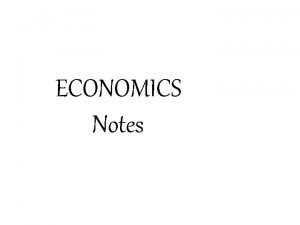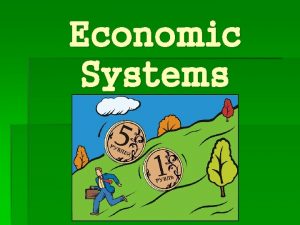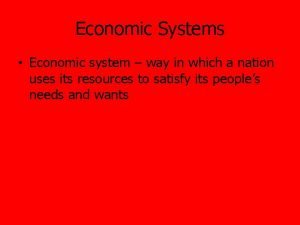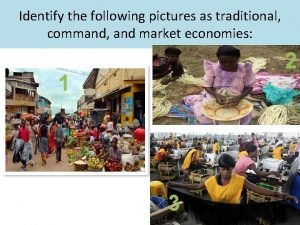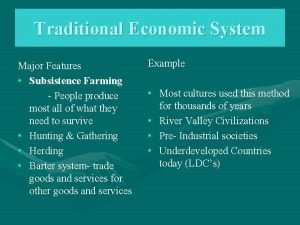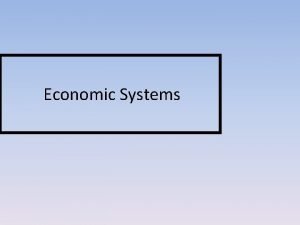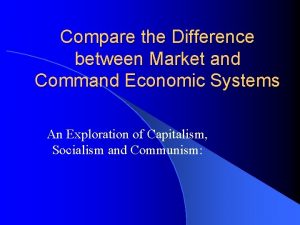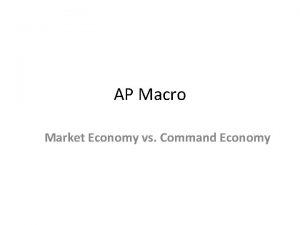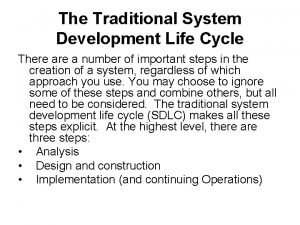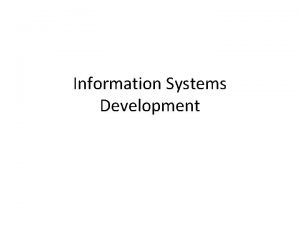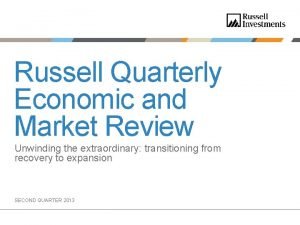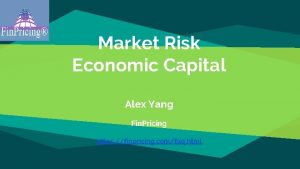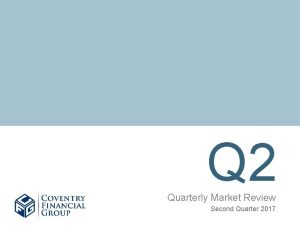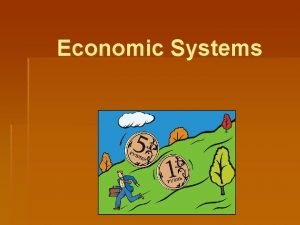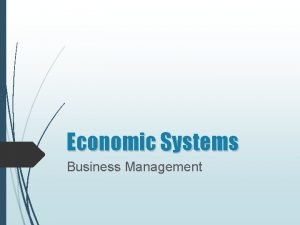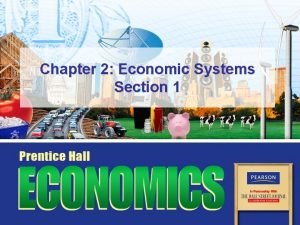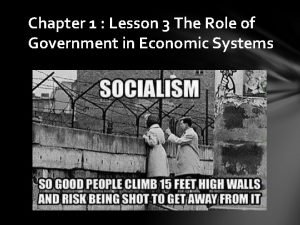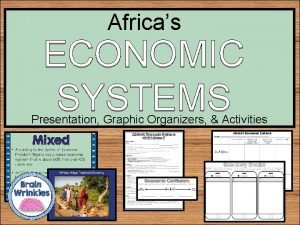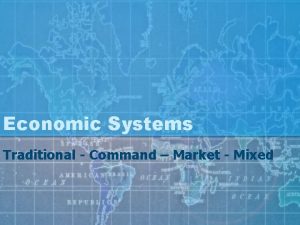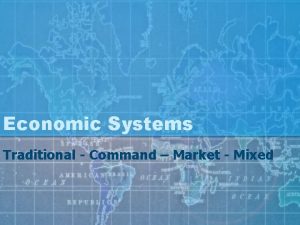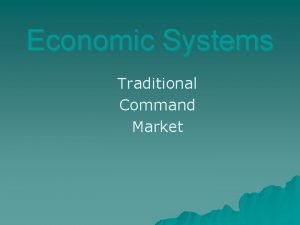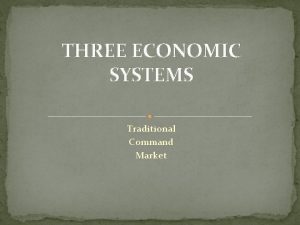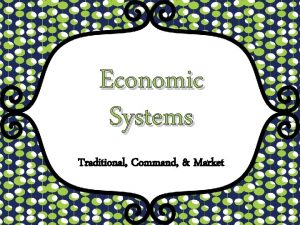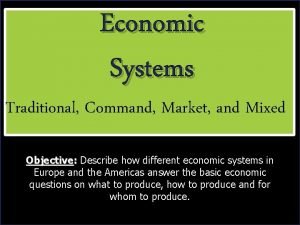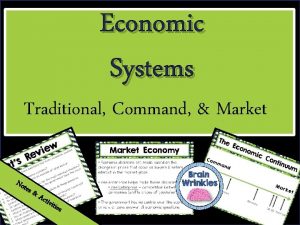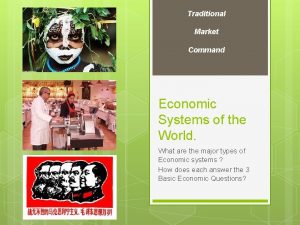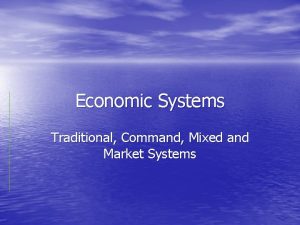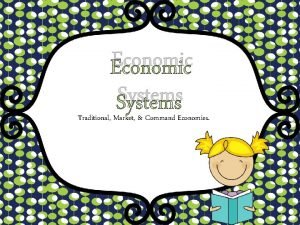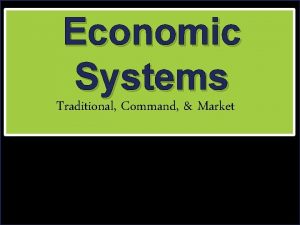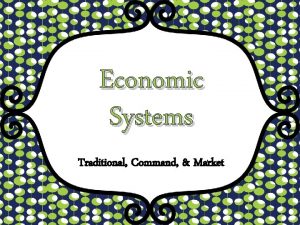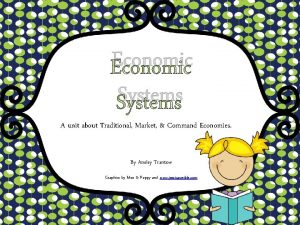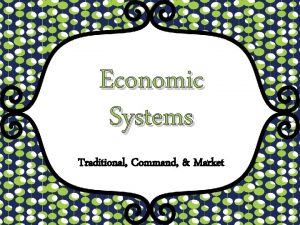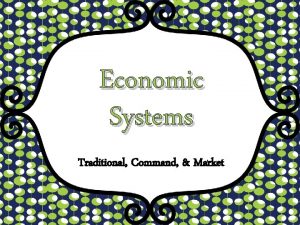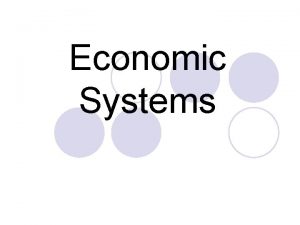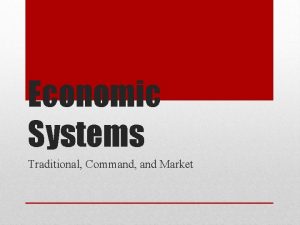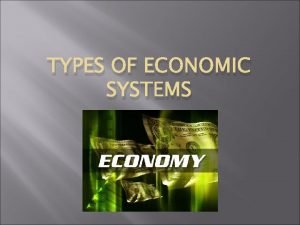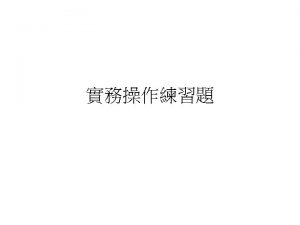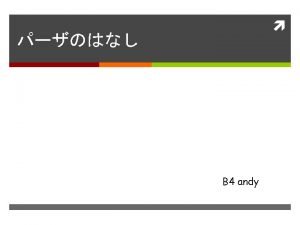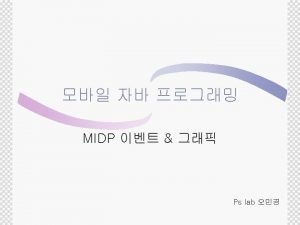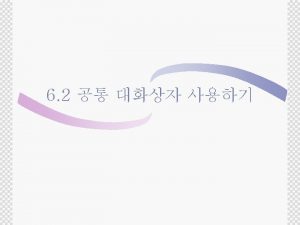Traditional Market Command Economic Systems of the World































- Slides: 31

Traditional Market Command Economic Systems of the World. What are the major types of Economic systems ? How does each answer the 3 Basic Economic Questions?

Three Economic Questions What goods and services will be produced? What How will they be produced? Hand Who do we have? > machine > elsewhere gets the stuff?

3 Economic Systems Economic system (economy) – an organized way of providing for the wants and needs of people. 1). Command 2). Market 3). Traditional

Traditional Economic Systems

Tradition, Tradition What, how and for whom to produce are answered by ritual, habits, customs Tribal Societies Across the world Communal living, little private property Advantages Disadvantages Methods Work Subsistence living Everyone knows Role Low standard of living Life is predictable and Discourages new ideas stable Never changes

Time to Get Creative!!!!! Describe what each of the following would look like in a traditional economy Waking You up in the morning and your friends hangout in the afternoon Going to get food for dinner

Communism : Command Gov’t No Private Property Rights Total o answers 3 Basic Economic Questions Government Control Government owns all resources!!!!!

Command Economies - Pros Allows an economy to change direction very quickly. After Stalin’s first two Five Year Plans, Russia moved from a rural agricultural economy to an industrial economy.

Command Economies - Pros Little uncertainty as to who will do what. No unemployment because the government gives everyone a job (whether it is needed or not). Ayn Rand - Anthem

Command Economies - Cons Not designed to meet the wants of consumers. Stalin’s Five Year Plan directed resources away from both agriculture and consumer goods. Provides strange incentives Do just enough to meet quotas.

Command Economies – More Cons No rewards for individual performance. No flexibility to handle problems. Requires a large decision making agency.

Circle the words that fit with Command Economies Lots of Choices Economic freedom Merit Pay Incentives to work Get what you need No Technology Happy Consumers Private Property Day to day flexibility North Korea Government housing Central planning Cuba Basic needs met Slow to change Equal distribution of wealth Government control Fast to change Tribes

Expansion of Communism

Stop, Collaborate and Listen What are the similarities and differences of Traditional and Command Economies? Command Traditional

Market Economy: Capitalism USA, Japan, UK, South Korea, South Africa, Canada

Market economies: Capitalism People/individuals answer the What, How, For Whom to Produce The First Economist – Adam Smith laissez faire “leave it alone” Invisible hand of self interest

Market Economies - Pros Economy Businesses can adapt to changing consumer tastes by creating new/different products. High can adjust to change over time degree of individual freedom Businesses and individuals are free to do what they want.

Market Economies – More Pros Small degree of government interference (Mixed Economy) Economic decisions are made by all, not limited to government officials. Seemingly unlimited variety of goods and services available to consumers.

Market Economies - Cons Does not provide for the basic needs of everyone. Elderly, disabled and other groups would be unable to survive in a market economy without governmental assistance.

Market Economies – More Cons Does not provide certain services that people value. National Defense & Education. High degree of uncertainty Tommy Boy Jobs going overseas Market Failures

What 3 economic questions are asked when studying the similarities of a traditional, command market economy among nations of the world? A. What to produce, why to produce, when to produce? B. What is your opportunity cost, what economic resources are needed, why should these resources be used? C. What to produce, how to produce, and for whom to produce? D. What is your opportunity cost, why are economic resources needed, when should these resources be used?

When a country has a market economy, which of these statements correctly defines this system? A. Workers are guaranteed a pay raise every year. B. The government controls most of the businesses in the country. C. Basic goods in the country are provided to all people without charge. D. Companies produce goods of their choice and consumers decide whether to buy the goods.

Which term best describes an economic system in which the people—not the government—own land, factories, and businesses? A. Communism B. Market C. Command D. Traditional

In a traditional economic system people usually exchange goods or services rather than use money. Which of the following is an example of this exchange process? A. charging goods on a credit card B. bartering with a seller C. paying for services by check D. using currency to pay

In which economic system are the production and distribution of goods owned by private individuals or corporations? A. traditional B. feudalism C. market D. command

Which of following best describes a market economy? A. A person can start any legal business and charge any price. B. The government provides food and housing to all workers. C. The government provides services, such as telephones and television. D. National businesses, such as airlines, are owned by the government.

A market economy is very different from a command economy. Which of the following is found in a market economy? A. Competition B. guaranteed yearly pay raises C. government control of industry D. government control of agriculture

In which economic system does a single authority decide what is produced? A. traditional B. Command C. Market D. Public

Which of the following explanations would reflect a country with a mixed economy (i. e. , between a pure market and pure command)? A. Prices and wages are solely regulated by a country’s government. B. A combination of privately-owned industry and government control. C. A country’s distribution of resources is based on inheritance. D. Prices and wages are determined by the laws of supply and demand rather than being regulated by a country’s government.

The economic system of communist countries is most closely related to which of the following? A. command B. market C. traditional D. supply and demand

 Economics unit 1 lesson 2 difficult choices
Economics unit 1 lesson 2 difficult choices Leader follower challenger nicher
Leader follower challenger nicher Market segmentation and positioning
Market segmentation and positioning Command economy pictures
Command economy pictures What is command economic system
What is command economic system What is command economic system
What is command economic system Command economy pictures
Command economy pictures Traditional economic system example
Traditional economic system example Traditional economic system example
Traditional economic system example Economical comparative and superlative
Economical comparative and superlative Economic growth vs economic development
Economic growth vs economic development Economic growth and development
Economic growth and development Similarities between market and command economy
Similarities between market and command economy Market vs command economy
Market vs command economy Traditional system life cycle
Traditional system life cycle Traditional approach in system analysis and design
Traditional approach in system analysis and design Traditional systems development life cycle
Traditional systems development life cycle Traditional clothing around the world
Traditional clothing around the world Russell quarterly economic and market review
Russell quarterly economic and market review Market risk economic capital
Market risk economic capital Russell quarterly economic and market review
Russell quarterly economic and market review Being resourceful meaning
Being resourceful meaning What is the purpose of an economic system
What is the purpose of an economic system Command economy examples
Command economy examples How many economic systems are there
How many economic systems are there Chapter 2 economic systems and decision making
Chapter 2 economic systems and decision making Traditional economy political cartoon
Traditional economy political cartoon Chapter 2 economic systems answer key
Chapter 2 economic systems answer key Chapter 2 economic systems and decision making
Chapter 2 economic systems and decision making Chapter 2 economic resources and systems
Chapter 2 economic resources and systems Lesson 3 the role of government in economic systems
Lesson 3 the role of government in economic systems Africa's economic systems comprehension check answer key
Africa's economic systems comprehension check answer key



